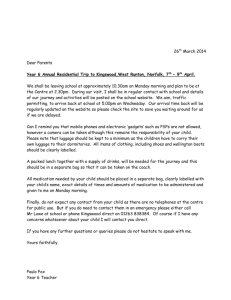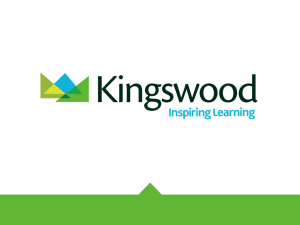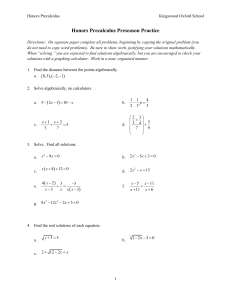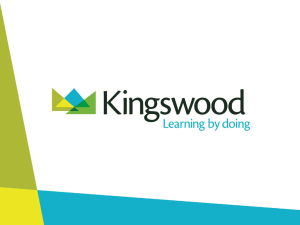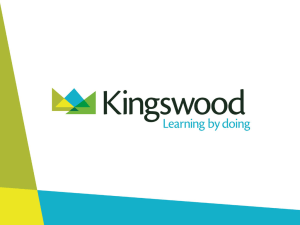School and Community Profile
advertisement
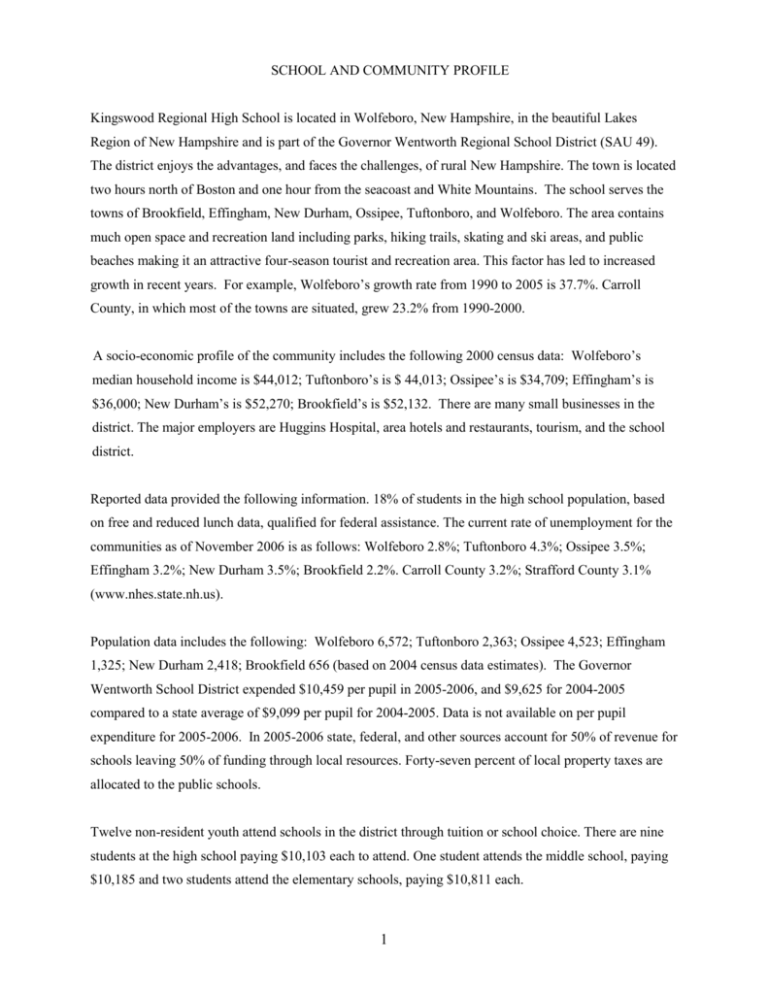
SCHOOL AND COMMUNITY PROFILE Kingswood Regional High School is located in Wolfeboro, New Hampshire, in the beautiful Lakes Region of New Hampshire and is part of the Governor Wentworth Regional School District (SAU 49). The district enjoys the advantages, and faces the challenges, of rural New Hampshire. The town is located two hours north of Boston and one hour from the seacoast and White Mountains. The school serves the towns of Brookfield, Effingham, New Durham, Ossipee, Tuftonboro, and Wolfeboro. The area contains much open space and recreation land including parks, hiking trails, skating and ski areas, and public beaches making it an attractive four-season tourist and recreation area. This factor has led to increased growth in recent years. For example, Wolfeboro’s growth rate from 1990 to 2005 is 37.7%. Carroll County, in which most of the towns are situated, grew 23.2% from 1990-2000. A socio-economic profile of the community includes the following 2000 census data: Wolfeboro’s median household income is $44,012; Tuftonboro’s is $ 44,013; Ossipee’s is $34,709; Effingham’s is $36,000; New Durham’s is $52,270; Brookfield’s is $52,132. There are many small businesses in the district. The major employers are Huggins Hospital, area hotels and restaurants, tourism, and the school district. Reported data provided the following information. 18% of students in the high school population, based on free and reduced lunch data, qualified for federal assistance. The current rate of unemployment for the communities as of November 2006 is as follows: Wolfeboro 2.8%; Tuftonboro 4.3%; Ossipee 3.5%; Effingham 3.2%; New Durham 3.5%; Brookfield 2.2%. Carroll County 3.2%; Strafford County 3.1% (www.nhes.state.nh.us). Population data includes the following: Wolfeboro 6,572; Tuftonboro 2,363; Ossipee 4,523; Effingham 1,325; New Durham 2,418; Brookfield 656 (based on 2004 census data estimates). The Governor Wentworth School District expended $10,459 per pupil in 2005-2006, and $9,625 for 2004-2005 compared to a state average of $9,099 per pupil for 2004-2005. Data is not available on per pupil expenditure for 2005-2006. In 2005-2006 state, federal, and other sources account for 50% of revenue for schools leaving 50% of funding through local resources. Forty-seven percent of local property taxes are allocated to the public schools. Twelve non-resident youth attend schools in the district through tuition or school choice. There are nine students at the high school paying $10,103 each to attend. One student attends the middle school, paying $10,185 and two students attend the elementary schools, paying $10,811 each. 1 There are 1,792 public elementary students in the district and 894 students enrolled in the high school as of January 2007. There is one non-public elementary school, one structurally attached vocational school, one private high school, and one alternative school in the district. Sending schools in the district for the high school and their enrollment data include Kingswood Regional Middle School (middle school enrollment 471); Cornerstone Christian Academy (middle school enrollment 14). Thirteen percent of high school students attend non-public high schools. English is the primary language of the entire district. Two students in the high school take instruction in ESOL (English for Speakers of Other Languages). Chapter I participation includes Ossipee and Effingham Elementary Schools as school-wide programs. Kingswood Regional Middle School is a targeted-assistance school. Data on students taking the SAT’s is as follows: in 2005-2006 there were 51 males and 58 females which calculates to 53.7% of seniors. In 2004-2005 53 males and 64 females or 60.6% of seniors took the SAT’s. Of the 2005-2006 senior class, 98.3% graduated, and 98.2% of seniors graduated in 2004-2005. No data is available on graduates’ performance in college. The percentage of students who were retained in each of the last two years is as follows: 1.8% for 20052006; 1.96% for 2004-2005. The total number of expulsions in each of the past two years was one; the total number of in-school suspensions for both years was one each year, as this procedure has been eliminated. The total number of out-of-school suspensions was 344 in 2005-2006 and 760 in 2004-2005. The district attributes this decrease of suspensions to the adoption of the PBIS (Positive Behavior Intervention System) program. The number of students with failing grades includes the following data: 2005-2006, 69 males and 32 females; 2004-2005, 85 males and 44 females. As of January 2007, the Kingswood Regional High School population for grades 9-12 was 894. The high school student population is generally age-appropriate for the grade level: Grade 9 – 233; Grade 10 – 235; Grade 11 – 225; Grade 12 – 201. There are no unusual age/grade variances at Lakeside Academy, the alternative school. Lakeside Academy has an enrollment of 50 students whose numbers are incorporated into the above figures. Enrollment projections are attached in the Appendix A. The primary feeder school is the structurally attached Kingswood Regional Middle School. One or two home-schooled students per year take courses at the high school. The composition of the student body consists of 99.83% Caucasian and .17% minority students. There has not been a significant change in the ethnic and racial composition of the student body in recent years. The school enrollment has been relatively stable. In 2004-2005, Barnstead students (formerly tuition students at KRHS) withdrew to form 2 a regional high school with Alton. The student attendance rate is 93% and the dropout rate is less than 2.4%. The percentage of dropouts as reported to the State Department of Education is as follows: 20052006, 2.4 % while the state average is 3.8%. The school year 2004-2005 showed a 4.3% dropout rate for Kingswood and a 3.5% rate for the state. The average daily teacher attendance is 96% for 2005-2006 and in 2004-2005 it was 88%. The school does not track teachers’ communication with parents. There is, however, data for the number of parent/teacher conferences held: 571 appointments made out of 2,372 possible or 24.1% in 2005-2006 and in 2004-2005, 702 appointments were made out of 2,411 possible which is 29.1 % participation. There is an annual parent/teacher night. The school has no transient or mobility issues in its student population. In the core academic areas of English, math, science, and social studies, gender distribution is equitable. Average class size in the academic area is as follows: Standard, 18 students; College Tech Prep, 20 students; Honors, 16 students; Advanced Placement, 15 students. There are 68.39 teachers, 4 administrators, 29.27 support staff members, and 25.53 non-professional staff. The high school offers 29 different clubs and a variety of different sports with an average of 200 fall sport athletes, 150 winter athletes, and 200 spring athletes participating in varsity, junior varsity and freshmen sports. Elective class sizes range from advanced AP French with 3 students to psychology with 23 students. Instructional time for students is 180 days by state law. Teachers have 185 contractual days which includes 5 in-service days. Additional educational programs available to students in the school include drivers’ education, the Running Start program (offered by NHTI), Project Lead the Way, adult education, summer school, and Penn Foster, the correspondence program. Examples of business or industry partnerships with the school include the School-to-Work program, job shadowing, Vocational Education Week, Career Day, the Blood Drive, work for the Humane Society, Friends of Music, after-prom activities, Grad Night, Relay for Life Program, Wish Upon-A-Star program, National Honor Society reading program, reading to preschoolers by the students in Child Development, and summer theatre. Some additional partnerships with the community include the Kingswood Youth Center, Life Bridge, and craft shows. Currently 14% of courses require a community service learning component, some of which may include the Kingswood Scholar Program, Big Brother/Big Sister Program, and the American Government course of study. There is no built-in common planning time for faculty. Some departments have lunch time meetings. The school works on a modified block schedule, and the majority of courses meet 90 minutes, five days a 3 week for one semester or one quarter. Most AP courses, band, chorus, and a small number of other classes meet for 45 minutes each school day for the entire year. Other small learning communities within the school include Junior/Senior Honors Program, Homework Help Club, the Great Books Program, Resource Room, and Guided Study. Students may elect to take courses at the Advanced Placement, Honors, College/Tech Prep, or Standard level. The placement of students entering grade nine is determined with input from the student and the teacher, subject to parental approval. The percentage of students in special education courses is 13%. The percentage of students in bilingual/ESL courses is .003%. The number of students taking upper level courses includes 58 students taking AP, and 247 taking honors classes. Honors classes include 98 males and 149 females. 136 students or 15.4% take standard level courses or are enrolled in self-contained classes. 14.3 % of the student population is enrolled in Standard level English. Students are not required to take all classes at the same level. 100% of the students take heterogeneously grouped classes; however, more male students have IEP’s than females (approximately 2:1 ratio). There are presently no students taking college courses on-line or on campus. Professional Development includes five in-service days per year, one faculty meeting per month, department meetings, as well as on and off-campus conferences and workshops. Professional development plans are no longer based on hourly requirements, but on the individual professional development plans and action research of each teacher. Many faculty attend additional workshops or conferences supported by the district. Post-secondary choices for the class of 2006 include the following: 46.4% went on to four-year colleges, 18.7% went on to two-year colleges, 13.2 % went on to immediate employment, 5.5 % went on to the military, 3.8% went on to other training programs. The remaining students went on to other endeavors or are unreported. There are no follow-up results on our graduates. Positive Behavior Intervention Systems (PBIS) and Teacher Mentoring are school reform initiatives undertaken to initiate student behavioral change at Kingswood. The PBIS program has affected our student population in a positive way as evidenced by the data on student behavior. This initiative was taken in order to improve school climate and discipline. See Appendix A for data regarding this initiative. New teachers are assigned mentors who meet with them before school starts and throughout the year. Mentors provide support and advice. 4 Grants that are currently in operation in this school which are federal or state supported include the following: Follow the Child, a five-day summer seminar for professionals in learning communities; Hands-on Optics, funded by the National Science Foundation; the drug and alcohol counselor for which Title IV federal funds pay a portion of the cost; World Language Week and other activities during the school year, funded by the Governor Wentworth Council for the Arts Grant. In addition, there is a summer program for developmentally delayed students and vocational programs funded by Perkins Funds. Project grants currently in operation which are supported by public and private foundations include the following: DHHS supports students in the health care field; Dr. Ted Wingate advises teachers and provides workshops on various issues; the Football Boosters program supports this sport; the Civil Air Patrol and the Air Force Association support the space technology program; Wolfeboro Friends of Music provides instructional concerts at the school. There are no teachers teaching out of their area of certification. There is currently one teacher who has a provisional teaching credential. Sixty-eight percent of the faculty holds an advanced degree. III. School Improvement Planning Based on lower than expected reading scores from the NH state testing program, one faculty member’s job description changed in order to provide services for students with reading difficulties. The high school has begun Measured Academic Progress (MAP) testing in English, and mathematics testing will begin in the winter of 2007, in order to better track performance of students based on competencies. The ninth graders who are repeating the grade have been put into a class which works continually to support their individual weaknesses so that these students can be brought up to grade level. The entire ninth grade curriculum is in the process of being restructured to further improve the performance of students with demonstrated weaknesses. The district is examining the math sequence of courses. Specialists have been brought in to conduct in-service activities, workshops, observations, and consultations for all teachers in the high school in the instruction of reading. Identified targets also include special education students in reading and math and low socio-economic students in reading and math. The school district’s overall goal is “to help each child create the future.” This dovetails nicely with the school’s mission statement relative to the attainment of viewing each student as an individual and enabling her or him to be successful. This year Power School and Power Grade were brought online to enable faculty to share data and to provide flexibility for viewing overall achievement of students with the eventual goal that parents will be able to monitor their children’s progress from home. Based on NECAP 5 scores, the math department is revamping some curriculum. Another identified target for improved school performance is the possible upgrade or construction of a new facility for the high school. The freshmen have been identified as a target for additional individualized programming. The Freshmen Academy came into being for one year to work toward this goal but was dissolved due to the lack of necessary space for students and common planning time for teachers. Kingswood Regional High School has identified the following as the most critical challenges facing the school: 1. Needed facility and infrastructure upgrade 2. Increased use of available student data by all professional staff 3. Follow-up data from students who have graduated 4. Continued emphasis on reading and writing in all curricular areas. 6
